Disputa com a ponte D. Luís o estatuto de ex-líbris do Porto. É a torre sineira da Igreja dos Clérigos e foi construída em meados do século XVII, com projeto do arquiteto italiano Nicolau Nasoni, que previa inicialmente uma segunda torre gémea. Tem seis andares e 75 metros de altura, que se sobem por uma escada em espiral com 240 degraus. Na altura da sua construção, era o edifício mais alto de Portugal. Está classificada pelo IPPAR como Monumento Nacional desde 1910.
30.6.17
Astronomy picture of the day - 2017 June 30 - NGC 7814: The Little Sombrero in Pegasus
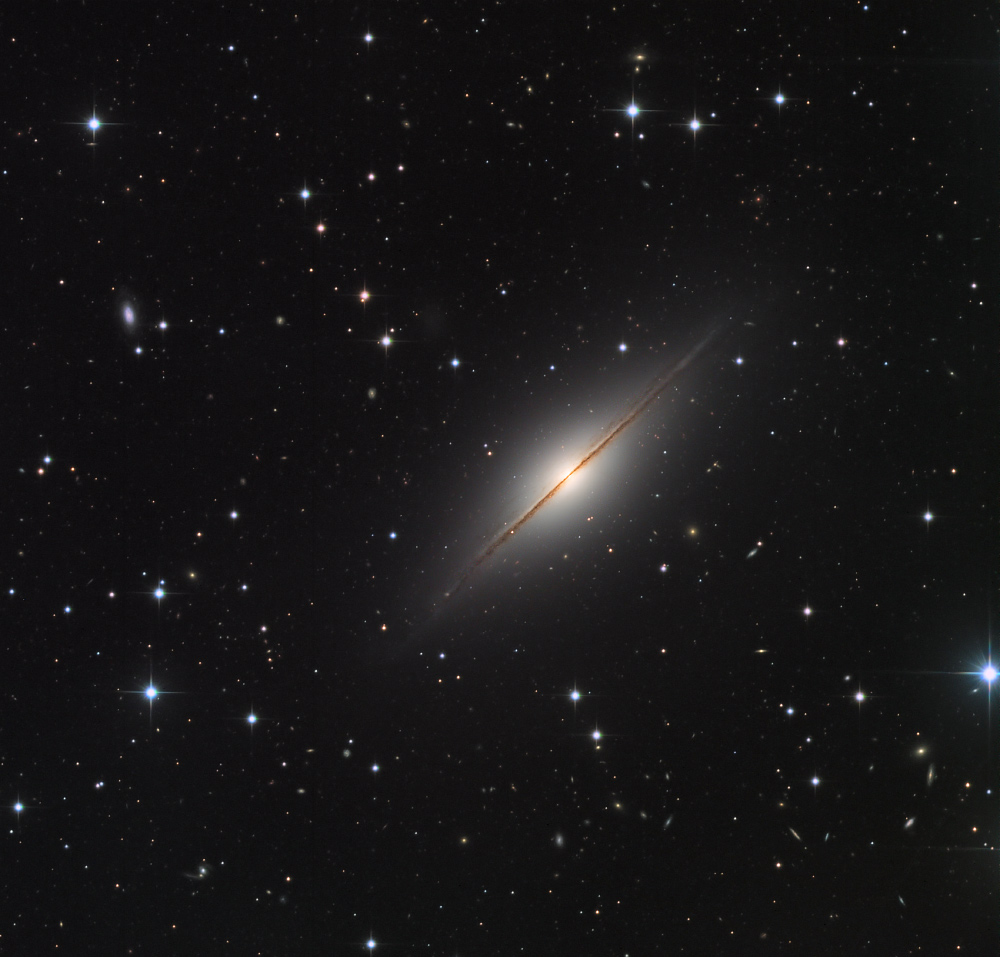
Image Credit & Copyright: CHART32 Team, Processing - Johannes Schedler
Explanation: Point your telescope toward the high flying constellation Pegasus and you can find this expanse of Milky Way stars and distant galaxies. Dominated by NGC 7814, the pretty field of view would almost be covered by a full moon. NGC 7814 is sometimes called the Little Sombrero for its resemblance to the brighter more famous M104, the Sombrero Galaxy. Both Sombrero and Little Sombrero are spiral galaxies seen edge-on, and both have extensive halos and central bulges cut by a thin disk with thinner dust lanes in silhouette. In fact, NGC 7814 is some 40 million light-years away and an estimated 60,000 light-years across. That actually makes the Little Sombrero about the same physical size as its better known namesake, appearing smaller and fainter only because it is farther away. Very faint dwarf galaxies, potentially a satellites of NGC 7814, have been discovered in deep exposures of Little Sombrero.
29.6.17
Imagenes del Mundo - Agricultor en - Naypyitaw, (Myanmar)
Un agricultor dispersa semillas de arroz en campos de lluvia en Naypyitaw, (Myanmar).
AUNG SHINE OO AP
Imagenes del Mundo - Duerme el bebé - Marawi (Filipinas)
Un bebé duerme dentro de una mosquitera en un centro de evacuación a las afueras de Marawi (Filipinas) mientras las fuerzas gubernamentales continúan su ataque contra los insurgentes.
JORGE SILVA REUTERS
Imagenes del Mundo - El niño y el gato - Manila (Filipinas)
Un niño rescata a una cría de gato que cayó a un río después de una operación de demolición de casas en Las Piñas, al sur de Manila (Filipinas).
FRANCIS R. MALASIG EFE
Imagenes del Mundo - Berna (Suiza)
Un rayo cae durante una tormenta eléctrica en la ciudad de Berna (Suiza).
ANTHONY ANEX EFE
Imagenes del Mundo - Bombay (India)
RAJANISH KAKADE AP
Imagens - Monumentos de Portugal - Mosteiro dos Jeronimos
Iniciado em 1501, no reinado de D. Manuel I, viria a ser concluído já no reinado de D. João III. Com a sua fachada de 300 metros, juntamente com a vizinha Torre de Belém, é um dos mais emblemáticos exemplos do chamado estilo manuelino, uma derivação do gótico em que abundam os pormenores decorativos com motivos náuticos, em celebração da epopeia dos descobrimentos. Está classificado como património mundial pela UNESCO.
Astronomy picture of the day - 2017 June 29 - Symbiotic R Aquarii

Image Credit: X-ray - NASA,CXC,SAO, R. Montez et al.; Optical - Adam Block, Mt. Lemmon SkyCenter, U. Arizona
Explanation: A long recognized naked-eye variable star, R Aquarii is actually an interacting binary star system, two stars that seem to have a close, symbiotic relationship. About 710 light years away, it consists of a cool red giant star and hot, dense white dwarf star in mutual orbit around their common center of mass. The binary system's visible light is dominated by the red giant, itself a Mira-type long period variable star. But material in cool giant star's extended envelope is pulled by gravity onto the surface of the smaller, denser white dwarf, eventually triggering a thermonuclear explosion and blasting material into space. Optical image data (red) shows the still expanding ring of debris originating from a blast that would have been seen in the early 1770s. The evolution of less understood energetic events producing high energy emission in the R Aquarii system has been monitored since 2000 using Chandra X-ray Observatory data (blue). The composite field of view is less that a light-year across at the estimated distance of R Aquarii.
28.6.17
Astronomy picture of the day - 2017 June 28 - Composite Messier 20 and 21
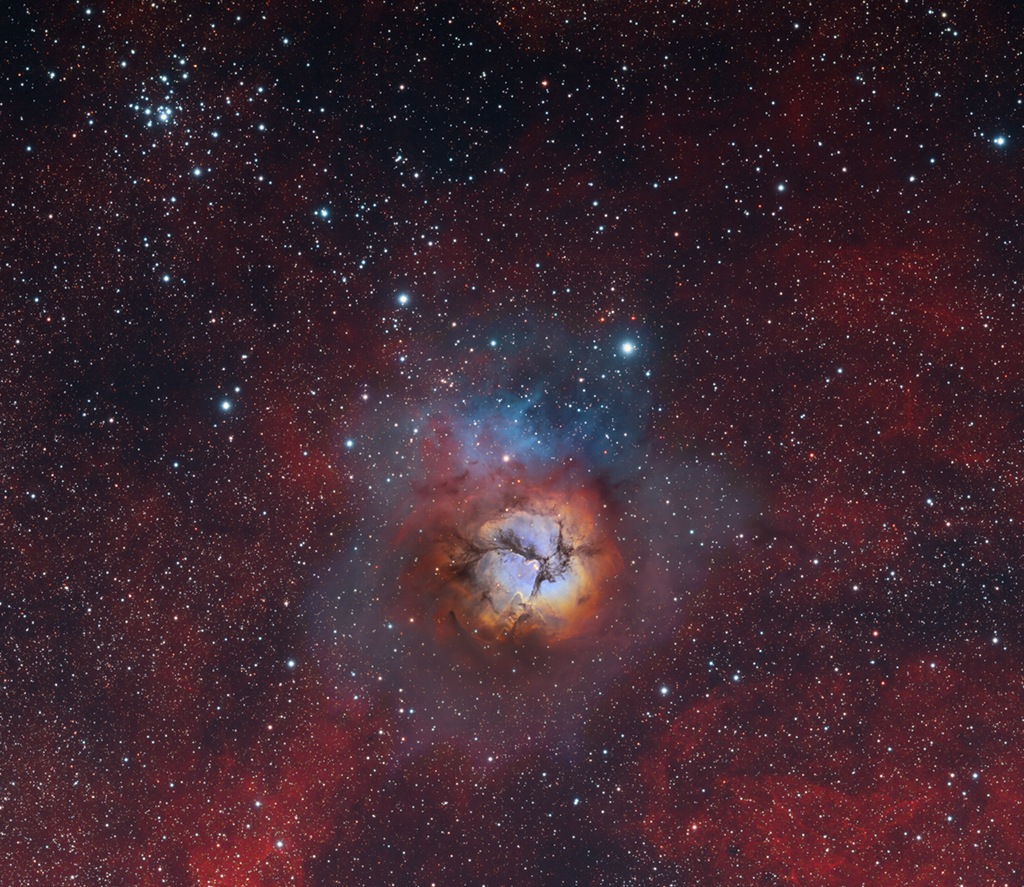
Image Credit & Copyright: Martin Pugh
Explanation: The beautiful Trifid Nebula, also known as Messier 20, lies about 5,000 light-years away, a colorful study in cosmic contrasts. It shares this nearly 1 degree wide field with open star cluster Messier 21 (top left). Trisected by dust lanes the Trifid itself is about 40 light-years across and a mere 300,000 years old. That makes it one of the youngest star forming regions in our sky, with newborn and embryonic stars embedded in its natal dust and gas clouds. Estimates of the distance to open star cluster M21 are similar to M20's, but though they share this gorgeous telescopic skyscape there is no apparent connection between the two. M21's stars are much older, about 8 million years old. M20 and M21 are easy to find with even a small telescope in the nebula rich constellation Sagittarius. In fact, this well-composed scene is a composite from two different telescopes. Using narrowband data it blends a high resolution image of M20 with a wider field image extending to M21.
26.6.17
Astronomy picture of the day - 2017 June 26 - Artistic Impression: The Surface of TRAPPIST-1f

Illustration Credit: NASA, JPL-Caltech, Spitzer Team, T. Pyle (IPAC)
Explanation: If you could stand on the surface of the newly discovered Earth-sized exoplanet TRAPPIST-1f, what would you see? Presently, no Earthling knows for sure, but the featured illustration depicts a reasoned guess based on observational data taken by NASA's Sun-orbiting Spitzer Space Telescope. In 2017, four more Earth-sized planets were found by Spitzer, including TRAPPIST-1f, in addition to three discovered in 2015 from the ground. From theplanet's surface, near the mild terminator between night and day, you might see water, ice, and rock on the ground, while water-based clouds might hover above. Past the clouds, the small central star TRAPPIST-1 would appear more red than our Sun, but angularly larger due to the close orbit. With seven known Earth-sized planets -- many of which pass near each other -- the TRAPPIST-1 system is not only a candidate to have life, but intercommunicating life -- although a preliminary search has found no obvious transmissions.
25.6.17
Astronomy picture of the day - 2017 June 25 - The N44 Superbubble

Image Credit & Copyright: Gemini Obs., AURA, NSF
Explanation: What created this gigantic hole? The vast emission nebula N44 in our neighboring galaxy the Large Magellanic Cloud has a large, 250 light-year hole and astronomers are trying to figure out why. One possibility is particle winds expelled by massive stars in the bubble's interior that are pushing out the glowing gas. This answer was found to be inconsistent with measured wind velocities, however. Another possibility is that the expanding shells of oldsupernovas have sculpted the unusual space cavern. An unexpected clue of hot X-ray emitting gas was recently been detected escaping the N44 superbubble. The featured image was taken in three very specific colors by the huge 8-meter Gemini South Telescope on Cerro Pachon in Chile.
24.6.17
Astronomy picture of the day - 2017 June 24 - Solstice Conjunction over Budapest

Image Credit & Copyright: György Soponyai
Explanation: Before a solstice Sun rose on June 21, brilliant Venus and an old crescent Moon posed together over Budapest, Hungary for this predawn skyscape. In the foreground the view looks across the Danube river from Buda to Pest toward the dome and peaks of the Hungarian Parliament building. Low clouds are in silhouette against a twilight sky. But far enough above the eastern horizon to catch the sunlight shines another seasonal apparition on that solstice morning, noctilucent clouds. Seen near sunrise and sunset in summer months at high latitudes, the night-shining clouds are formed as water vapor in the cold upper atmosphere condenses on meteoric dust or volcanic ash near the edge of space.
22.6.17
Astronomy picture of the day - 2017 June 22 -

Image Credit: Cassini Imaging Team, SSI, JPL, ESA, NASA
Explanation: While yesterday's solstice brought summer to planet Earth's northern hemisphere, a northern summer solstice arrived for ringed planet Saturn nearly a month ago on May 24. Following the Saturnian seasons, its large moon Titan was captured in this Cassini spacecraft image from June 9. The near-infrared view finds bright methane clouds drifting through Titan's northern summer skies as seen from a distance of about 507,000 kilometers. Below Titan's clouds, dark hydrocarbon lakes sprawl near the large moon's now illuminated north pole.
21.6.17
Astronomy picture of the day - 2017 June 21 - A Sundial that Shows Solstice
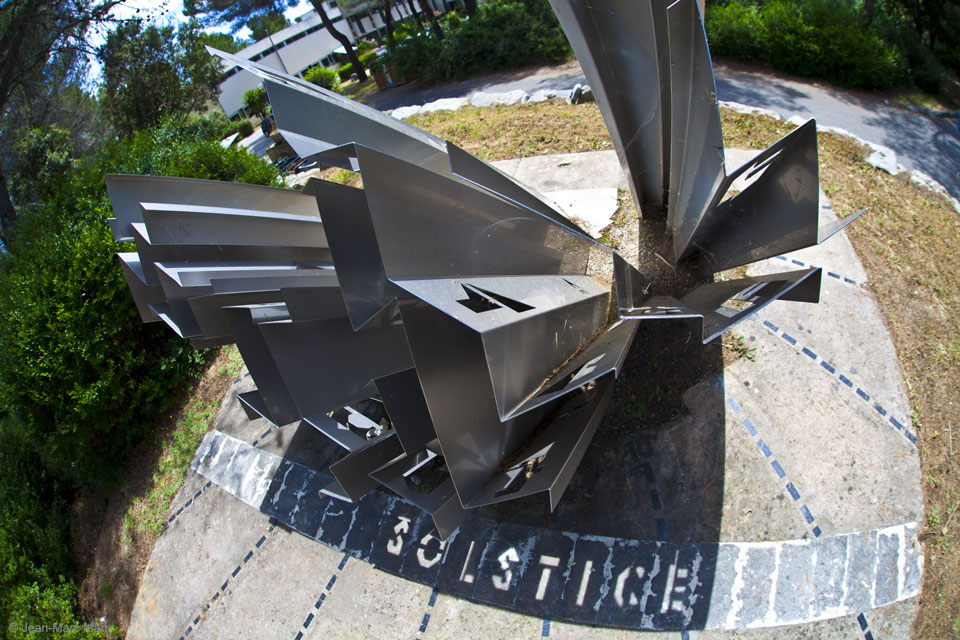
Image Credit & Copyright: Jean-Marc Mari
Explanation: What day is it? If the day -- and time -- are right, this sundial will tell you: SOLSTICE. Only then will our Sun be located just right for sunlight to stream through openings and spell out the term for the longest and shortestdays of the year. But this will happen today (and again in December). The sundial was constructed by Jean Salins in 1980 and is situated at the Ecole Supérieure des Mines de Paris in Valbonne Sophia Antipolis of south-eastern France. On two other days of the year, watchers of this sundial might get to see it produce another word: EQUINOXE.
20.6.17
Astronomy picture of the day - 2017 June 20 - The Massive Stars in Westerlund 1

Image Credit: ESA/Hubble & NASA
Explanation: Star cluster Westerlund 1 is home to some of the largest and most massive stars known. It is headlined by the star Westerlund 1-26, a red supergiant star so big that if placed in the center of our Solar System, it would extend out past the orbit of Jupiter. Additionally, the young star cluster is home to 3 other red supergiants, 6 yellow hypergiant stars, 24 Wolf-Rayet stars, and several even-more unusual stars that continue to be studied. Westerlund 1 is relatively close-by for a star cluster at a distance of 15,000 light years, giving astronomers a good laboratory to study the development of massive stars. The featured image of Westerlund 1 was taken by the Hubble Space Telescopetoward the southern constellation of the Altar (Ara). Although presently classified as a "super" open cluster, Westerlund 1 may evolve into a low mass globular cluster over the next billion years.
18.6.17
Artigo - TRAGEDIA em Portugal
Fogo em Góis continua ativo e com muita intensidade
O incêndio que deflagrou no sábado, no concelho de Góis, distrito de Coimbra, “permance ativo” e a área “continua a arder com muita intensidade”, disse à agência Lusa a Autoridade Nacional de Proteção Civil.
Paulo Santos, oficial de Operações e Emergência, da Autoridade Nacional de Proteção Civil, acrescentou que o incêndio está em curso “há 23 horas e 20 minutos” e mobiliza “387 operacionais, 112 veículos e seis meios aéreos”.
Depois do fogo florestal que deflagrou em Pedrógão Grande, no distrito de Leiria – e que provocou pelo menos 62 mortes, segundo as últimas atualizações -, “este é o incêndio que mais meios mobiliza”, referiu.
“O incêndio continua a arder com muita intensidade”, numa “área florestal com proximidade com habitações”, referiu ainda.
Observador - Portugal
17.6.17
Astronomy picture of the day - 2017 June 17 - Saturn near Opposition

Image Credit & Copyright: D. Peach, E. Kraaikamp, F. Colas, M. Delcroix, R. Hueso, G. Therin, C. Sprianu, S2P, IMCCE, OMP
Explanation: Saturn reached its 2017 opposition on June 16. Of course, opposition means opposite the Sun in Earth's sky and near opposition Saturn is up all night, at its closest and brightest for the year. This remarkably sharp imageof the ringed planet was taken only days before, on June 11, with a 1-meter telescope from the mountain top Pic du Midi observatory. North is at the top with the giant planet's north polar storm and curious hexagon clearly seen bathed in sunlight. But Saturn's spectacular ring system is also shown in stunning detail. The narrow Encke division is visible around the entire outer A ring, small ringlets can be traced within the fainter inner C ring, and Saturn's southern hemisphere can be glimpsed through the wider Cassini division. Near opposition Saturn's rings also appear exceptionally bright, known as the opposition surge or Seeliger Effect. Directly illuminated from Earth's perspective, the ring's icy particles cast no shadows and strongly backscatter sunlight creating the dramatic increase in brightness. Still, the best views of the ringed planet are currently from the Saturn-orbiting Cassini spacecraft. Diving close, Cassini's Grand Finale orbit number 9 is in progress.
16.6.17
Astronomy picture of the day - 2017 June 16 - Manhattan Moonrise
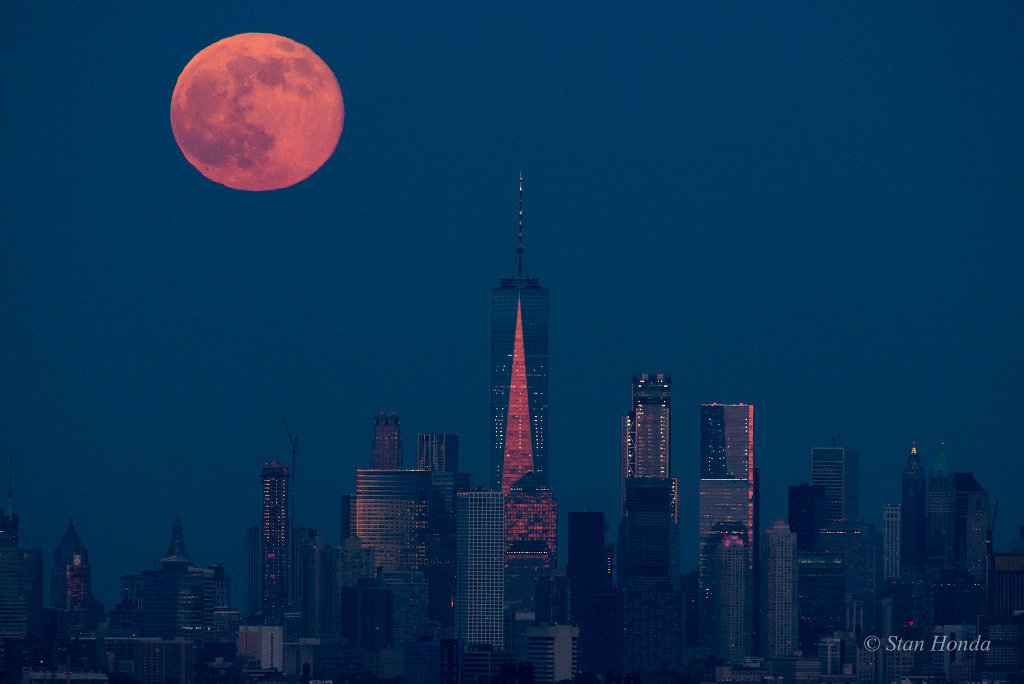
Image Credit & Copyright: Stan Honda
Explanation: A Full Moon rose as the Sun set on June 9, known to some as a Strawberry Moon. Close to the horizon and taking on the warm color of reflected sunlight filtered through a dense and dusty atmosphere, the fully illuminated lunar disk poses with the skyscrapers along the southern Manhattan skyline in this telephoto snapshot. The picture was taken from Eagle Rock Reservation, a park in West Orange, New Jersey, planet Earth. That's about 13 miles from southern Manhattan and some 240,000 miles from the Moon. Foreground faces of the modern towers of steel and glass share the Moon's warm color by reflecting the last rays of the setting Sun. The tallest, with the shining triangular facet, is New York City's One World Trade center.
15.6.17
Astronomy picture of the day - 2017 June 15 - Red Sprites over the Channel
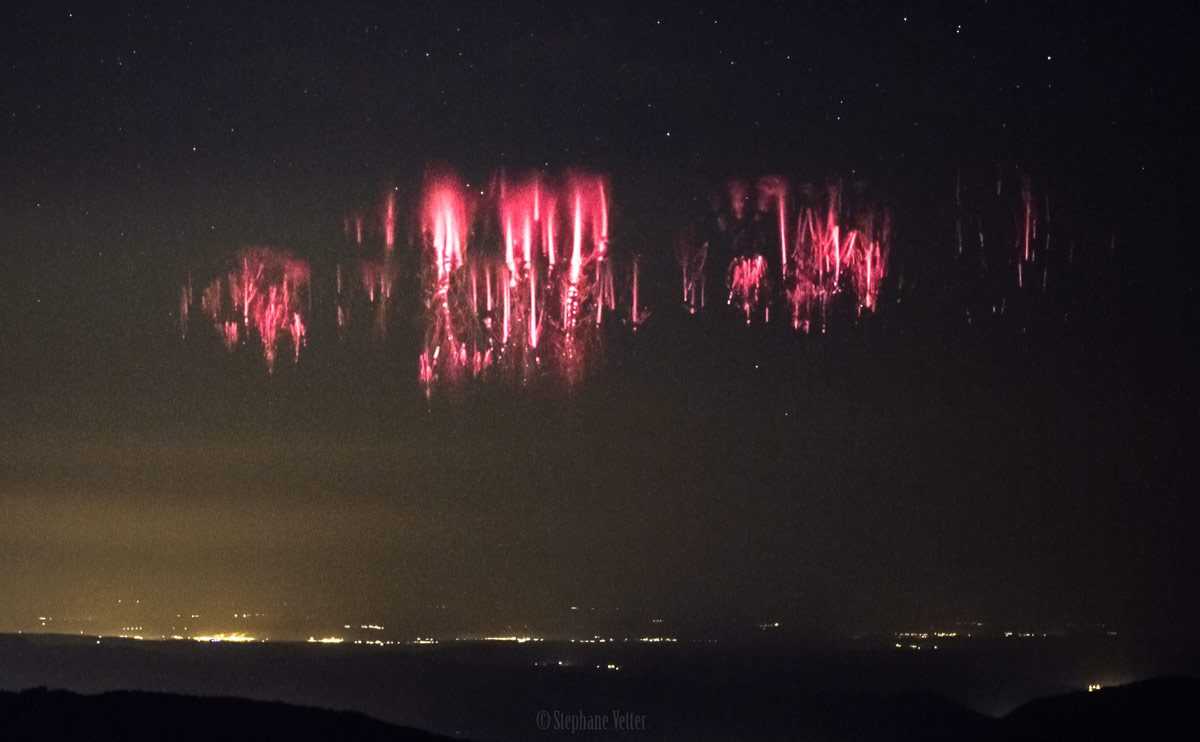
Image Credit & Copyright: Stephane Vetter (Nuits sacrees, TWAN)
Explanation: Mysterious and incredibly brief, red sprites are seen to occur high above large thunderstorms on planet Earth. While they have been recorded from low Earth orbit or high flying airplanes, these dancing, lightning-like events were captured in video frames from a mountain top perch in northern France. Taken during the night of May 28, the remarkably clear, unobstructed view looks toward a multicell storm system raging over the English Channel about 600 kilometers away. Lasting only a few milliseconds, the red sprite association with thunderstorms is known. Still, much remains a mystery about the fleeting apparitions including the nature of their relation to other upper atmospheric lightning phenomena such as blue jets or satellite detected terrestrial gamma flashes.
14.6.17
Astronomy picture of the day - 2017 June 14M89: Elliptical Galaxy with Outer Shells and Plumes
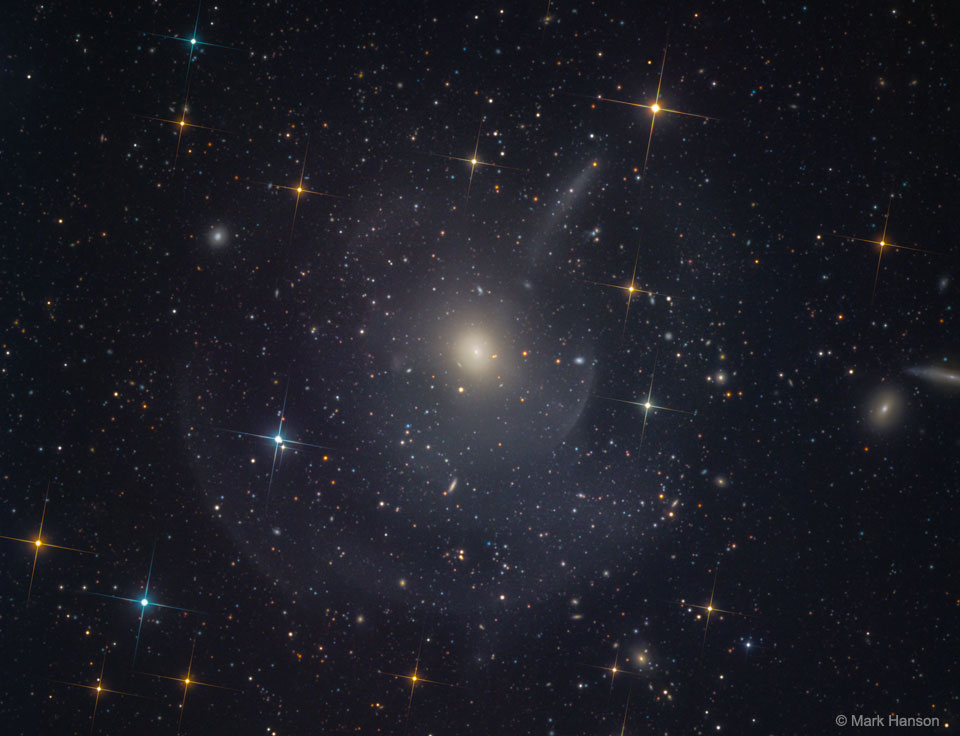
Image Credit & Copyright: Mark Hanson
Explanation: Can you see them? This famous Messier object M89, a seemingly simple elliptical galaxy, is surrounded by faint shells and plumes. The cause of the shells is currently unknown, but possibly tidal tails related to debris left over from absorbing numerous small galaxies in the past billion years. Alternatively the shells may be like ripples in a pond, where a recent collision with another large galaxy created density waves that ripple through this galactic giant. Regardless of the actual cause, the featured image highlights the increasing consensus that at least some elliptical galaxies have formed in the recent past, and that the outer halos of most large galaxies are not really smooth but havecomplexities induced by frequent interactions with -- and accretions of -- smaller nearby galaxies. The halo of our own Milky Way Galaxy is one example of such unexpected complexity. M89 is a member of the nearby Virgo cluster ofgalaxies which lies about 50 million light years distant.
13.6.17
Astronomy picture of the day - 2017 June 13 - The Great Nebula in Carina
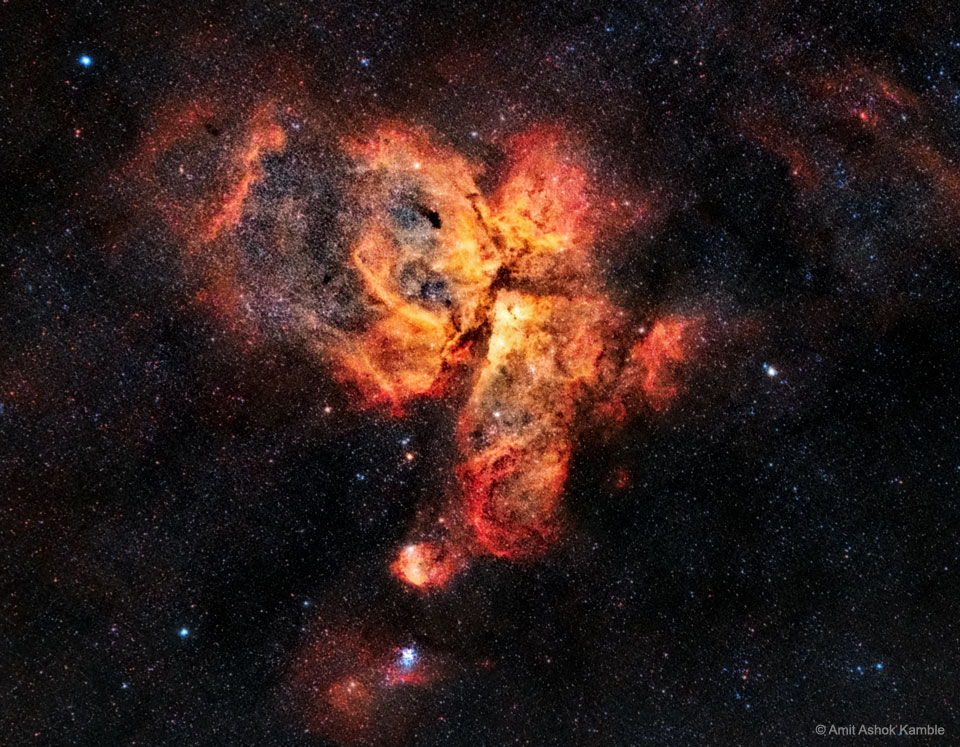
Image Credit & Copyright: Amit Ashok Kamble
Explanation: In one of the brightest parts of Milky Way lies a nebula where some of the oddest things occur. NGC 3372, known as the Great Nebula in Carina, is home to massive stars and changing nebulas. The Keyhole Nebula(NGC 3324), the bright structure just to the right of the image center, houses several of these massive stars and has itself changed its appearance. The entire Carina Nebula, captured here, spans over 300 light years and lies about 7,500 light-years away in the constellation of Carina. Eta Carinae, the most energetic star in the nebula, was one of the brightest stars in the sky in the 1830s, but then faded dramatically. While Eta Carinae itself maybe on the verge of a supernova explosion, X-ray images indicate that much of the Great Nebula in Carina has been a veritable supernova factory.
12.6.17
Expressões populares portuguesas - Colocar panos quentes
Significado: Favorecer ou acobertar coisa errada feita por outro; complacência; frouxidão nas atitudes ou sanções.
Origem: Em termos terapêuticos, colocar panos quentes é uma receita, embora paliativa, prescrita pela medicina popular desde tempos remotos. Recomenda-se sobretudo nos estados febris, pois a temperatura muito elevada pode levar a convulsões e a problemas daí decorrentes.
Nesses casos, compressas de panos encharcados com água quente são um santo remédio. A sudorese resultante tem efeito benéfico, faz baixar a febre. Em urgentes trabalhos de parto a aplicação de panos quentes também é bastante comum.
Seja como for, para apaziguar conflitos ou melhorar desconfortos físicos, o uso de panos quentes é sempre aconselhável.
Astronomy picture of the day - 2017 June 12 - An Unusual Hole in Mars
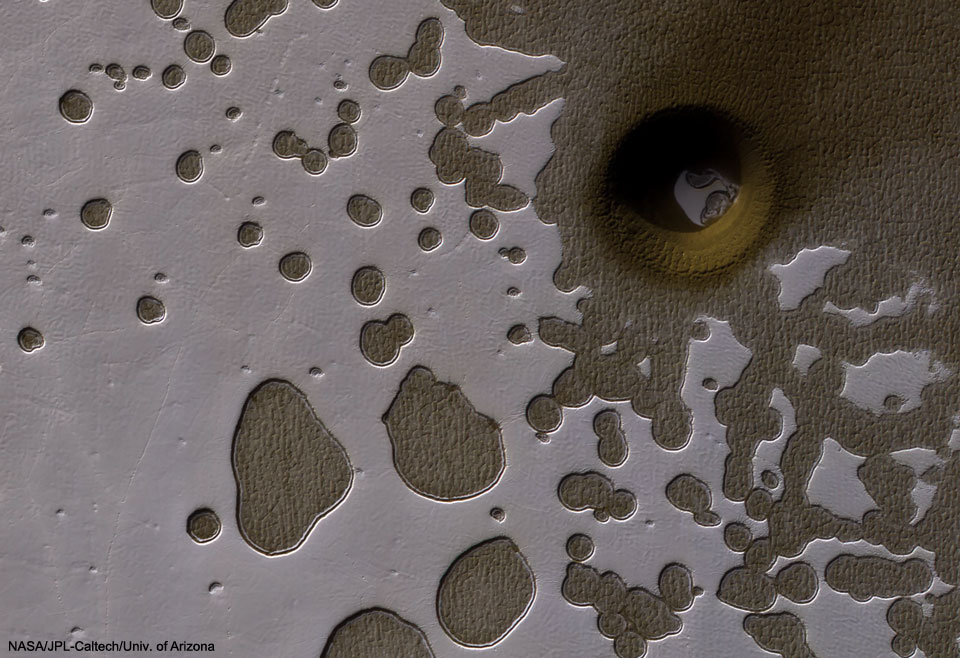
Image Credit: NASA, MRO, HiRISE, JPL, U. Arizona
Explanation: What created this unusual hole in Mars? Actually, there are numerous holes pictured in this Swiss cheese-like landscape, with all-but-one of them showing a dusty, dark, Martian terrain beneath evaporating, light, carbon-dioxide ice. The most unusual hole is on the upper right, spans about 100-meters, and seems to punch through to a lower level. Why this hole exists and why it is surrounded by a circular crater remains a topic of speculation, although a leading hypothesis is that it was created by a meteor impact. Holes such as this are of particular interest because they might be portals to lower levels that extend into expansive underground caves. If so, these naturally-occurring tunnels are relatively protected from the harsh surface of Mars, making them relatively good candidates to contain Martian life. These pits are therefore prime targets for possible future spacecraft, robots, and even human interplanetary explorers.
11.6.17
Astronomy picture of the day - 2017 June 11 - IC 418: The Spirograph Nebula
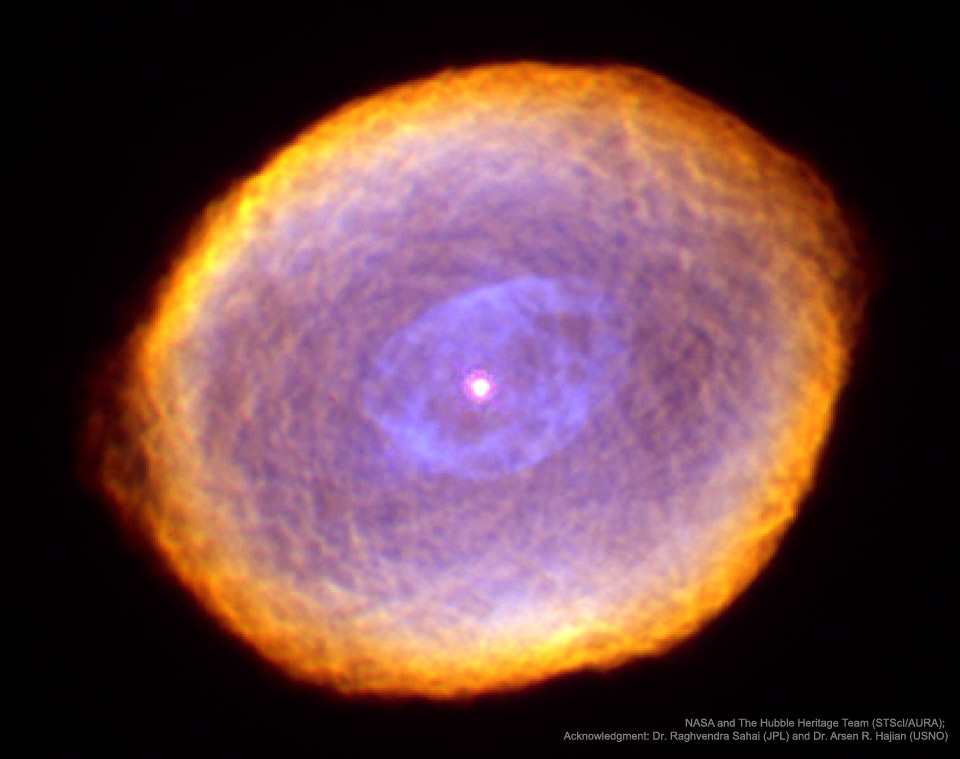
Image Credit: NASA, ESA, and the Hubble Heritage Team (STScI/AURA); Acknowledgement: R. Sahai (JPL) et al.
Explanation: What is creating the strange texture of IC 418? Dubbed the Spirograph Nebula for its resemblance to drawings from a cyclical drawing tool, planetary nebula IC 418 shows patterns that are not well understood. Perhaps they are related to chaotic winds from the variable central star, which changes brightness unpredictably in just a few hours. By contrast, evidence indicates that only a few million years ago, IC 418 was probably a well-understood star similar to our Sun. Only a few thousand years ago, IC 418 was probably a common red giant star. Since running out of nuclear fuel, though, the outer envelope has begun expanding outward leaving a hot remnant core destined to become a white-dwarf star, visible in the image center. The light from the central core excites surrounding atoms in the nebula causing them to glow. IC 418 lies about 2000 light-years away and spans 0.3 light-years across. This false-color image taken from the Hubble Space Telescope reveals the unusual details.
10.6.17
Astronomy picture of the day - 2017 June 10 - Saturn in the Milky Way
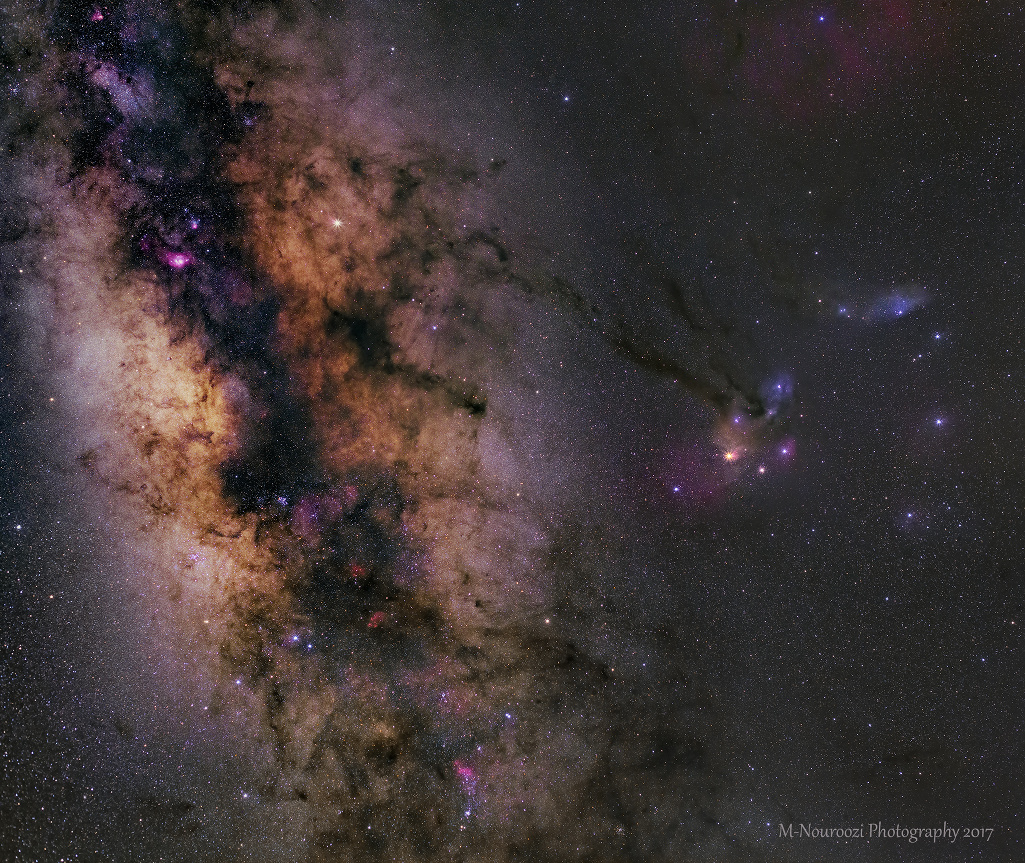
Image Credit & Copyright: Mohammad Nouroozi
Explanation: Saturn is near opposition in planet Earth's sky. Rising at sunset and shining brightly throughout the night, it also lies near a line-of-sight to crowded starfields, nebulae, and obscuring dust clouds along the Milky Way. Whitish Saturn is up and left of center in this gorgeous central Milky Way skyscape, a two panel mosaic recorded earlier this month. You can find the bright planet above the bowl of the dusty Pipe nebula, and just beyond the end of adark river to Antares, alpha star of the constellation Scorpius. For now the best views of the ringed giant planet are from the Saturn-orbiting Cassini spacecraft, though. Diving close, Cassini's Grand Finale orbit number 8 is in progress.
9.6.17
Expressões populares portuguesas - Estar na berlinda
Significado: Estar em evidência, em foco.
Origem: Estar expressão relaciona-se com os jogos de prendas, em que, da roda, sai uma pessoa que vai para a berlinda, onde se sujeita aos comentários dos outros jogadores. Depois, de acordo com as variantes, ou adivinha a autoria dos comentários ou escolhe um deles, sempre sem saber quem os fez. O responsável pela observação eleita será o próximo a ir para a berlinda. Foi por isso que a expressão passou a ser usada em relação às pessoas que estão em evidência ou despertam a curiosidade dos outros, ficando sujeitas a todo o tipo de ditos e mexericos.
Atestada desde finais do século XIX, esta palavra parece ter vindo do italiano "berlina" - zombaria. Mas berlinda é também a designação de uma carruagem usada outrora, cujo nome provém do francês "bérline", que, por sua vez, tem origem no nome da capital alemã, Berlim. É que foi esta a cidade que viu nascer, no século XVIII, o primeiro exemplar dessa carruagem, concebida por Filipe Chiese. Tinha quatro rodas, quatro assentos e era suspensa inicialmente por tiras de couro, que, mais tarde, foram substituídas por molas. O -d- que passou a integrar berlinda pode justificar-se por influência do adjectivo linda, devido à elegância do coche.
Astronomy picture of the day - 2017 June 9 - M27: Not a Comet
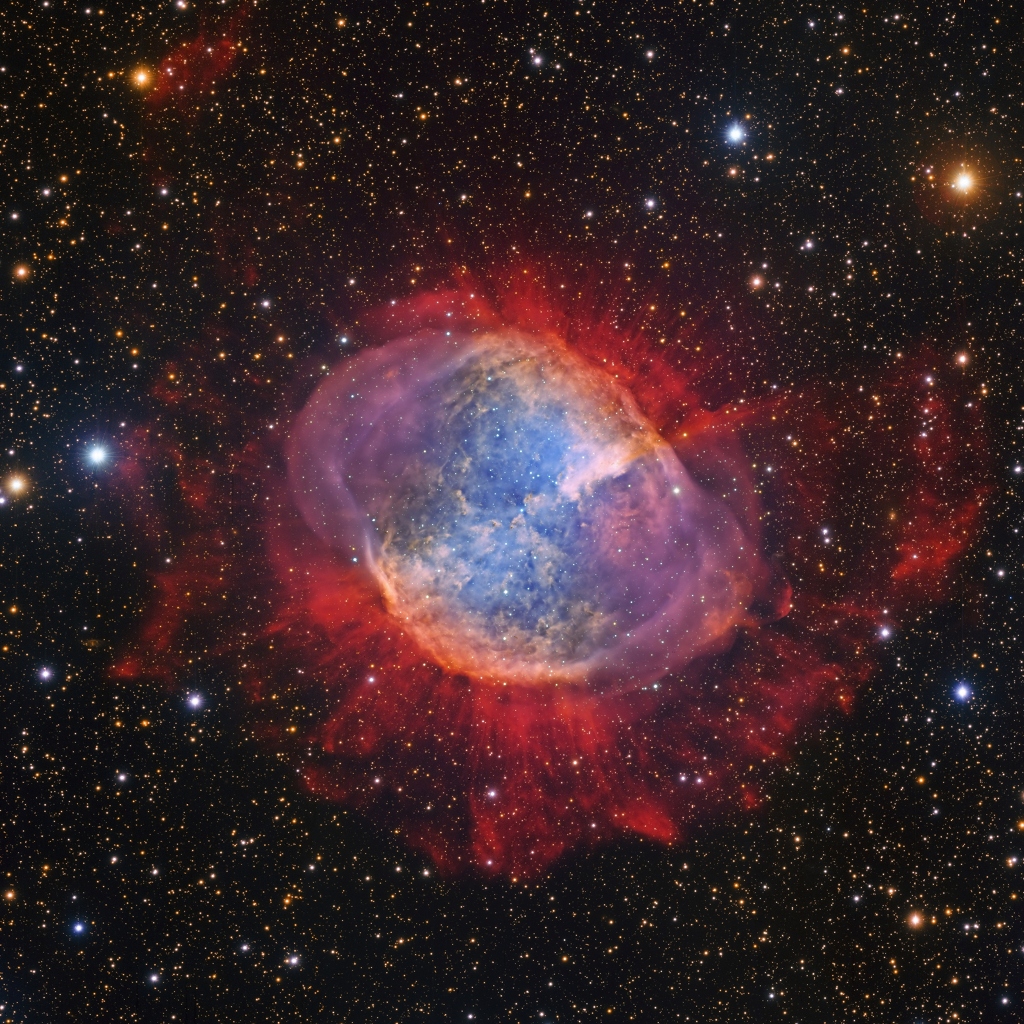
Image Credit & Copyright: Data; Subaru, NAOJ, Assembly and Processing; Roberto Colombari
Explanation: While hunting for comets in the skies above 18th century France, astronomer Charles Messier diligently kept a list of the things he encountered that were definitely not comets. This is number 27 on his now famous not-a-comet list. In fact, 21st century astronomers would identify it as a planetary nebula, but it's not a planet either, even though it may appear round and planet-like in a small telescope. Messier 27 (M27) is an excellent example of agaseous emission nebula created as a sun-like star runs out of nuclear fuel in its core. The nebula forms as the star's outer layers are expelled into space, with a visible glow generated by atoms excited by the dying star's intense but invisible ultraviolet light. Known by the popular name of the Dumbbell Nebula, the beautifully symmetric interstellar gas cloud is over 2.5 light-years across and about 1,200 light-years away in the constellation Vulpecula. This spectacular color image incorporates broad and narrowband observations recorded by the 8.2 meter Subaru telescope.
8.6.17
Astronomy picture of the day - 2017 June 8 - Firefall by Moonlight
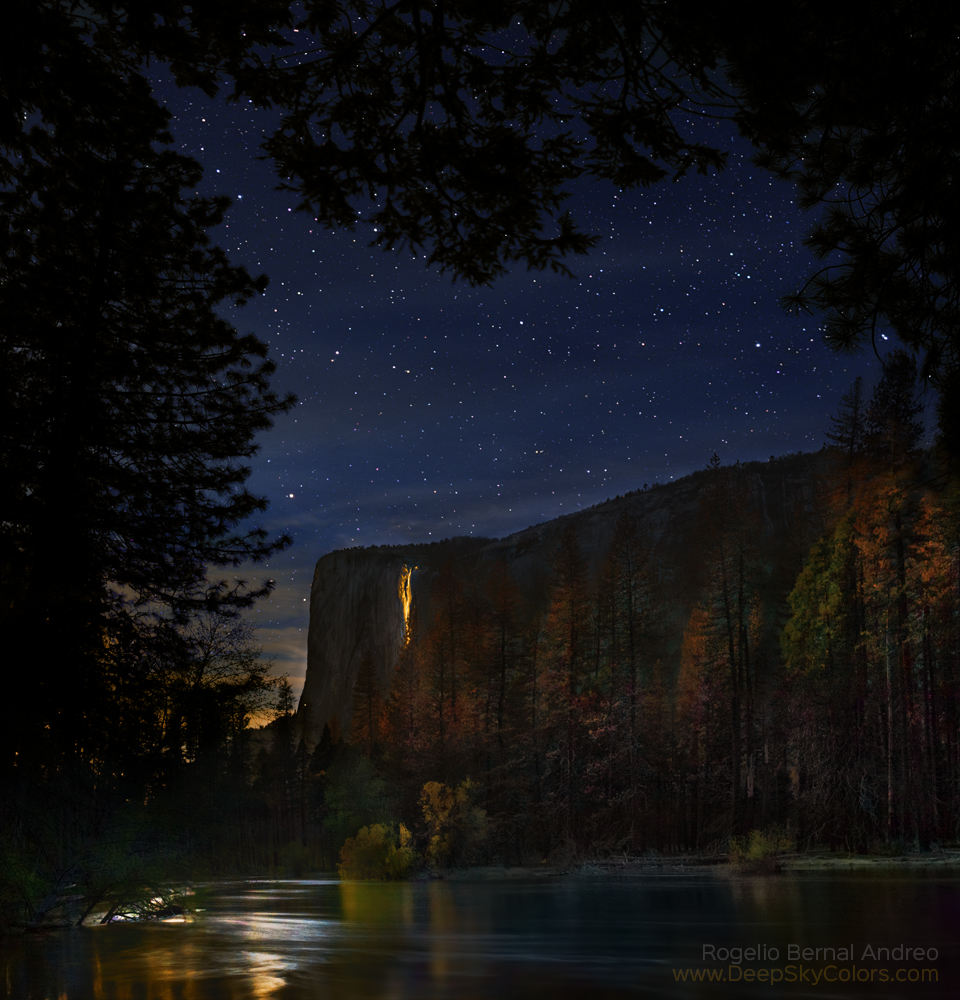
Image Credit & Copyright: Rogelio Bernal Andreo (Deep Sky Colors)
Explanation: On certain dates in February, an elusive firefall can be spotted at sunset in Yosemite National Park, when the weather cooperates and the direction to the setting Sun is just right. Often photographed from vantage points below, at the right moment the park's seasonal Horsetail Fall is isolated in the shadows of the steep walls of El Capitan but still illuminated with rays of sunlight reflected by the angled rockface directly behind the flow, briefly giving the waterfall a dramatic fiery appearance. The Horsetail firefall is more rarely photographed at moonset under a starry night sky, though. Even more elusive by moonlight, the firefall effect can also be seen when skies are clear and a bright Moon sets at the right direction along the western horizon. Skies were clear and stars were shining for this well-planned photograph of the Horsetail firefall lit by a gibbous Moon setting in the early morning hours of May 9.
7.6.17
Astronomy picture of the day - 2017 June 7 - Orbiting Jupiter
Video Credit & License: NASA, Juno, SwRI, MSSS, Gerald Eichstadt, Sean Doran
Explanation: What would it be like to orbit Jupiter? The dramatic featured video depicts just this and was made from images taken by NASA's Juno spacecraft currently orbiting the Jovian giant. Juno recently completed its sixth passnear Jupiter during its looping elliptical six-week orbit. As the time-lapse video starts, alternating dark and light cloud bands passed underneath the spacecraft as it approaches Jupiter's South Pole. These clouds contain complex textures involving eddies, swirls, ovals, and extended clouds that are have no direct analog from Earth. As the spacecraft passes beneath Jupiter, new cloud patterns devoid of long bands emerge but are again rich with alien swirls and ovals. Over the next few years, Juno will continue to orbit and probe Jupiter, determine atmospheric water abundance, and attempt to determine if Jupiter has a solid surface underneath these fascinating clouds.
6.6.17
Astronomy picture of the day - 2017 June 6 - The Case of the Missing Star

Image Credit: NASA, ESA, Hubble, C. Kochanek (OSU)
Explanation: What's happened to giant star N6946-BH1? It was there just a few years ago -- Hubble imaged it. Now there's only a faint glow. What's curiouser, no bright supernova occurred -- although the star did brightened significantly for a few months. The leading theory is that, at about 25 times the mass of our Sun, N6946-BH1's great gravity held much of the star together during its final tumultuous death throes, after which most the star sunk into ablack hole of its own making. If so, then what remained outside of the black hole likely then formed an accretion disk that emits comparatively faint infrared light as it swirls around, before falling in. If this mode of star death is confirmed with other stars, it gives direct evidence that a very massive star can end its life with a whimper rather than a bang.
5.6.17
Astronomy picture of the day - 2017 June 5 - Highlights of the Summer Sky

Illustration Credit & Copyright: Universe2go.com
Explanation: What's up in the sky this summer? The featured graphic gives a few highlights for Earth's northern hemisphere. Viewed as a clock face centered at the bottom, early summer sky events fan out toward the left, while late summer events are projected toward the right. Objects relatively close to Earth are illustrated, in general, as nearer to the cartoon figure with the telescope at the bottom center -- although almost everything pictured can be seen without a telescope. Highlights of this summer's sky include that Jupiter will be visible after sunset during June, while Saturn will be visible after sunset during August. A close grouping of the Moon, Venus and the bright star Aldebaran will occur during mid-July. In early August, the Perseids meteor shower peaks. Surely the most famous pending astronomical event occurring this summer, though, will be a total eclipse of the Sun visible over a thin cloud-free swath across the USA on 21 August.
4.6.17
Astronomy picture of the day - 2017 June 4 - Orion: Belt, Flame, and Horsehead
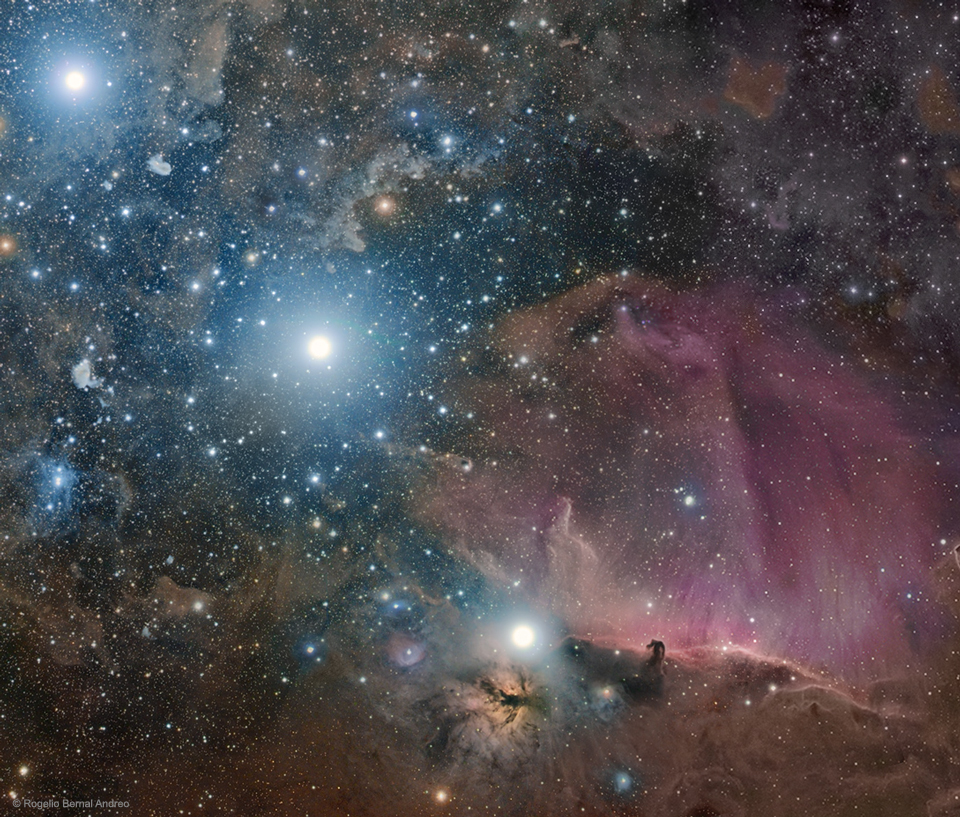
Image Credit & Copyright: Rogelio Bernal Andreo (Deep Sky Colors)
Explanation: What surrounds the famous belt stars of Orion? A deep exposure shows everything from dark nebula to star clusters, all embedded in an extended patch of gaseous wisps in the greater Orion Molecular Cloud Complex.The brightest three stars, appearing diagonally on the left of the featured image are indeed the famous three stars that make up the belt of Orion. Just below Alnitak, the lowest of the three belt stars, is the Flame Nebula, glowing withexcited hydrogen gas and immersed in filaments of dark brown dust. Just to the right of Alnitak lies the Horsehead Nebula, a dark indentation of dense dust that has perhaps the most recognized nebular shapes on the sky. The dark molecular cloud, roughly 1,500 light years distant, is cataloged as Barnard 33 and is seen primarily because it is backlit by the nearby massive star Sigma Orionis. The Horsehead Nebula will slowly shift its apparent shape over the next few million years and will eventually be destroyed by the high-energy starlight.
3.6.17
Imagens - "La Terre vue de l'Espace" - Venise
"Venise, la cité des Doges – et des amoureux – dans sa lagune. On voit presque les gondoles !"
Thomas Pesquet
Thomas Pesquet
Astronomy picture of the day - 2017 June 3 - Perijove Passage

Image Credit: NASA, Juno, SwRI, MSSS, Gerald Eichstadt, Sean Doran
Explanation: On May 19, the Juno spacecraft once again swung by Jupiter in its looping 53 day orbit around the Solar System's ruling gas gaint. Beginning at the top, this vertical 14 frame sequence of enhanced-color JunoCam images follows the spacecraft's rapidly changing perspective during its two hour passage. They look down on Jupiter's north polar region, equatorial, and south polar region (bottom images). With the field-of-view shrinking, the seventh and eighth images in the sequence are close-up. Taken only 4 minutes apart above Jupiter's equator they were captured just before the spacecraft reached perijove 6, its closest approach to Jupiter on this orbit. Final images in the sequence pick up white oval storm systems, Jupiter's "String of Pearls", and the south polar region from the outward bound spacecraft.
2.6.17
Astronomy picture of the day - 2017 June 2 - Black Holes of Known Mass
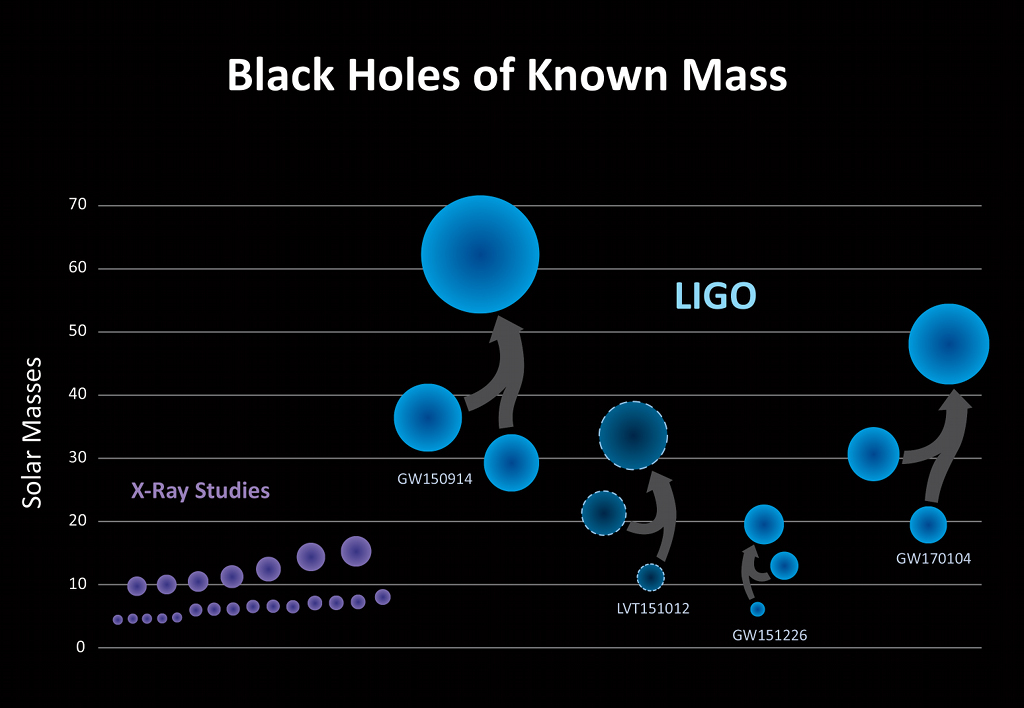
Illustration Credit: LIGO, NSF, Aurore Simonnet (Sonoma State U.)
Explanation: Add GW170104 to the chart of black holes with known mass. The extremely energetic merger of two smaller black holes corresponds to the Laser Interferometer Gravitational-wave Observatory's (LIGO) thirddetection of gravitational waves. The newfound black hole has a mass about 49 times that of the Sun, filling a gap between the masses of the two merged black holes detected previously by LIGO, with solar masses of 62 (GW150914) and 21 (GW151216). In all three cases, the signal in each of the twin LIGO detectors was unambiguously identified as coming from black hole mergers while a fourth case (LVT151012) resulted in a lower confidence detection. GW170104 is estimated to be some 3 billion light-years away, more distant than present estimates for GW150914 and GW151216. The ripples in spacetime were discovered during LIGO's current observing run, which began November 30, 2016 and will continue through the summer.
1.6.17
Astronomy picture of the day - 2017 June 1 - Shadowrise and Sunset
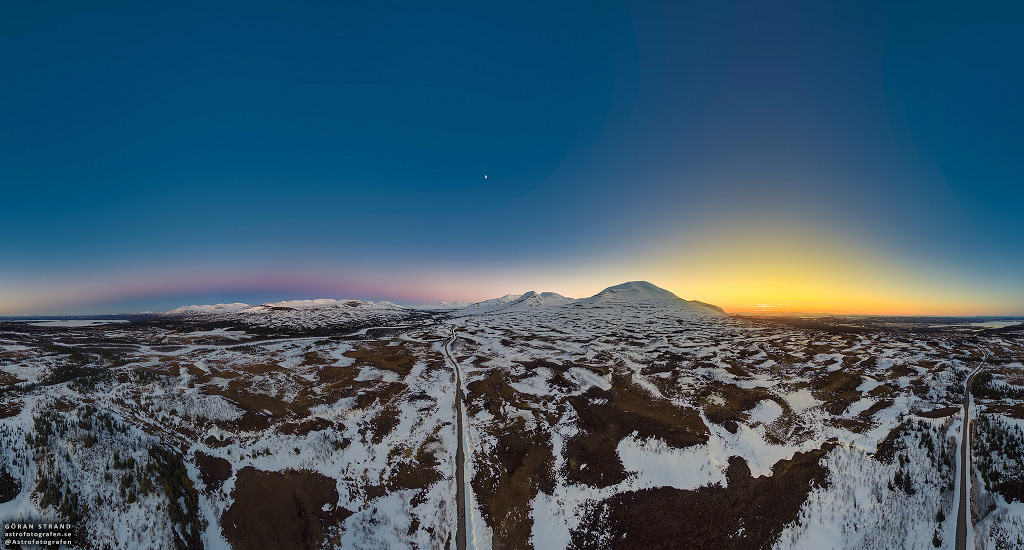
Image Credit & Copyright: Göran Strand
Explanation: The road tracking through this stunning 360 degree view crosses a remote mountain area of Jämtland, Sweden, planet Earth. A 3x8 mosaic of still images, the panorama was taken on May 3rd from a small drone 200 meters above the ground. The scene records the warm light of the Sun setting in the northwest and the planet's dark shadow rising in the southeast. A small sun pillar gives away the Sun's position just below the horizon while the pinkishanti-twilight arch or belt of Venus outlines Earth's shadow. In the middle of the remarkably clear sky, the First Quarter Moon is visible above the mountains, its half illuminated disk separating sunset and shadowrise. A range of exposures were combined to cover the difference in sky brightness for sunset and Earth shadow. The tallest peak left of the sunset is Storsnasen, some 1400 meters above sea level.
Inscription à :
Articles (Atom)




